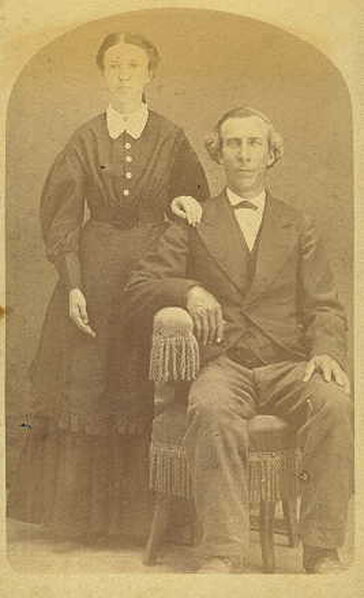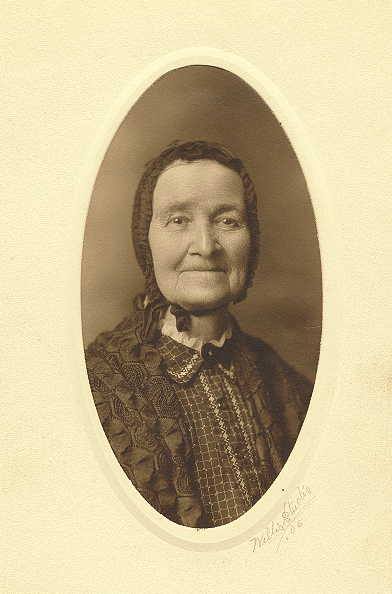Remley - Family (Sarah McCain)


David
Remley, a Remley family descendant donated to the Crawfordsville
District Public Library and the Carnegie Museum a large collection of
family artifacts relating to John (1800-1876) and Sarah (McCain) Remley,
early county settlers. Among the items are the family's 1830s-1840s era
muzzleloader, believed to be the one that Sarah fired one night in
defense of her flock of chickens, not realizing that she had killed an
Indian. Other items in the collection include two family Bibles, one of
which was copyrighted in 1823, with hand-written records of their
children's births; tax receipts from 1832; John Remley's pocketbook
(wallet); daguerreotypes of John and Sarah Remley, and more. You may
notice that the Remleys originally spelled their name Ramley in the
inscriptions.
Here is a bit more in regards to the famous chicken story, told to me by Jeff, another of their descendants. This is my great, great, great grandmother, Sarah McCain Remley. She came to Indiana in the 1820s and carved a life out of the wilderness in a small one room cabin. At the end of their lives, she and her husband had 2,000 acres of farmland. I have a small child's bible which she gave to her granddaughter, also named Sarah, in 1883 as a Christmas gift, and written inside the cover it says "from Grand Ma Remley"..
Sarah
came to Cville in 1824 on horseback in the company of several male
relatives. Her husband was meanwhile on a flatboat bringing their
belongings down the Ohio, up the Wabash and by land from Terre Haute; a
very hard slog. Their cabin was on a bluff above Sugar Creek, just North
of what is now Country Club Road west of Cville. The location is now a
nice subdivision, I think it's called Sugar Cliff. After her cabin
burned, they built a more substantial house over it, and as their family
grew they simply added more rooms to the house. It's now a very large,
old brick house in a subdivision surrounded by new homes, built where
the Remley fruit orchard used to be. I forget the names of the current
owners, but they have lovingly restored the house and know much about
the Remleys who built it. When it was just a one room cabin, they had a
path down the bluff to Sugar Creek, where they had a small milkhouse and
they kept butter cold in a crock in the stream. Once Sarah went to get
some butter and found a fish in the butter! You can still see where that
path was today, as there are a few stone steps in the hillside. Partway
down the hill was a chicken coop, and this brings to mind the
controversial story I mentioned. John had to go back to Cincinnatti to
get supplies, but he left Sarah with her sister at the cabin to keep her
company. One night they heard a commotion at the chicken coop and were
afraid it was a wolf or other animal trying to get to the chickens. It
was dark and they were afraid, so they opened the cabin door slightly,
aimed the gun barrell in the general direction of the coop, and fired
one shot to scare away whatever it was. The commotion stopped, and the
women went back to sleep. Next morning, they went out to see if any
chickens had been lost, and as they started down the path, they saw a
man's arm hanging limp over the chicken coop. They had shot an Indian
without realizing it! They were afraid his people would come looking for
him so they disposed of the body. As I heard the story, they never told
exactly how they did so. But they probably just buried him somewhere.
Until John returned, they continued to do chores etc. by night only and
stayed inside by day out of fear. One night Sarah went down to the
milkhouse to churn butter, and was so afraid at the noise the churn
made. She said that the path was particularly spooky during that time
when she was afraid the natives would come looking for the man that was
killed.
Jeff had other nifty stories about the Remley family. “David Remley told a story of an elderly Native American man who would come to her door and shout "Whisk!! Whisk!!" She denied having any "whisk" but he gained entrance to her cabin and searched for himself. Upon finding a jug beneath the bed, he took a drink (of vinegar) and said "No Whisk!!!" and then left. David Remley said that he did not believe the Remleys partook of alcohol and thus had none in their home.”
“David also told a story of one day when Sarah and John were riding into town in their carriage on what is now Country Club Road, headed East towards town, and crossing a bridge over the creek at the low spot in the road that is still there. As they reached the bridge, there were two Native American men fighting in the creek with a knife. One was overweight, and he was sliced in the belly with the knife, leaving a flap of skin hanging. He tried to repair himself to no avail, and eventually just removed the flap of skin and ate it! The story continued that the man with the knife was taken before a Native council for punishment, and had his ear cut off for doing such violence. It was said that neither man cried from his injuries. I am not sure how the Remleys learned of the "rest of the story" from that fight, but I'm sure word traveled in the small community, and perhaps they served as witnesses?”
“Sarah and John had 11 children, the first of whom died in infancy. Her son, Ambrose, was my G, G Grandfather, and spent 4 years as a corporal in the Union army. He wrote many letters home, and also kept a detailed diary of his experiences, all of which were edited by my uncle and published chronologically by the Montgomery County Historical Society in 1997. Having visited the Remley home, I could imagine his mother tearing open each of those letters and anxiously reading them aloud in the parlor to the rest of the family. He frequently expressed his longing for the things of home, fruit from the orchard, his mother's cooking, etc. All of these stories, even those from David Remley that I had not heard before, were attributed to my great grandmother, Sarah "Sally" Remley Herr, who was Sarah McCain's granddaughter. I did not know Sally, but my mom and aunts knew her well, and so whether from David or our branch of the family, these stories are really only one generation removed from the person who lived them. Thus I believe they are quite accurate, and importantly, took place in places which can be seen today and are generally familiar to locals like us, even though it was a wilderness then.
“ Jeff
Thanks so much to Jeff for sharing his “family,” and especially that darling, brave lady’s picture, as well as the Crawfordsville Library’s Staff and Jeff’s ancestors! Greatly appreciate you all sharing for the GenWeb page.
